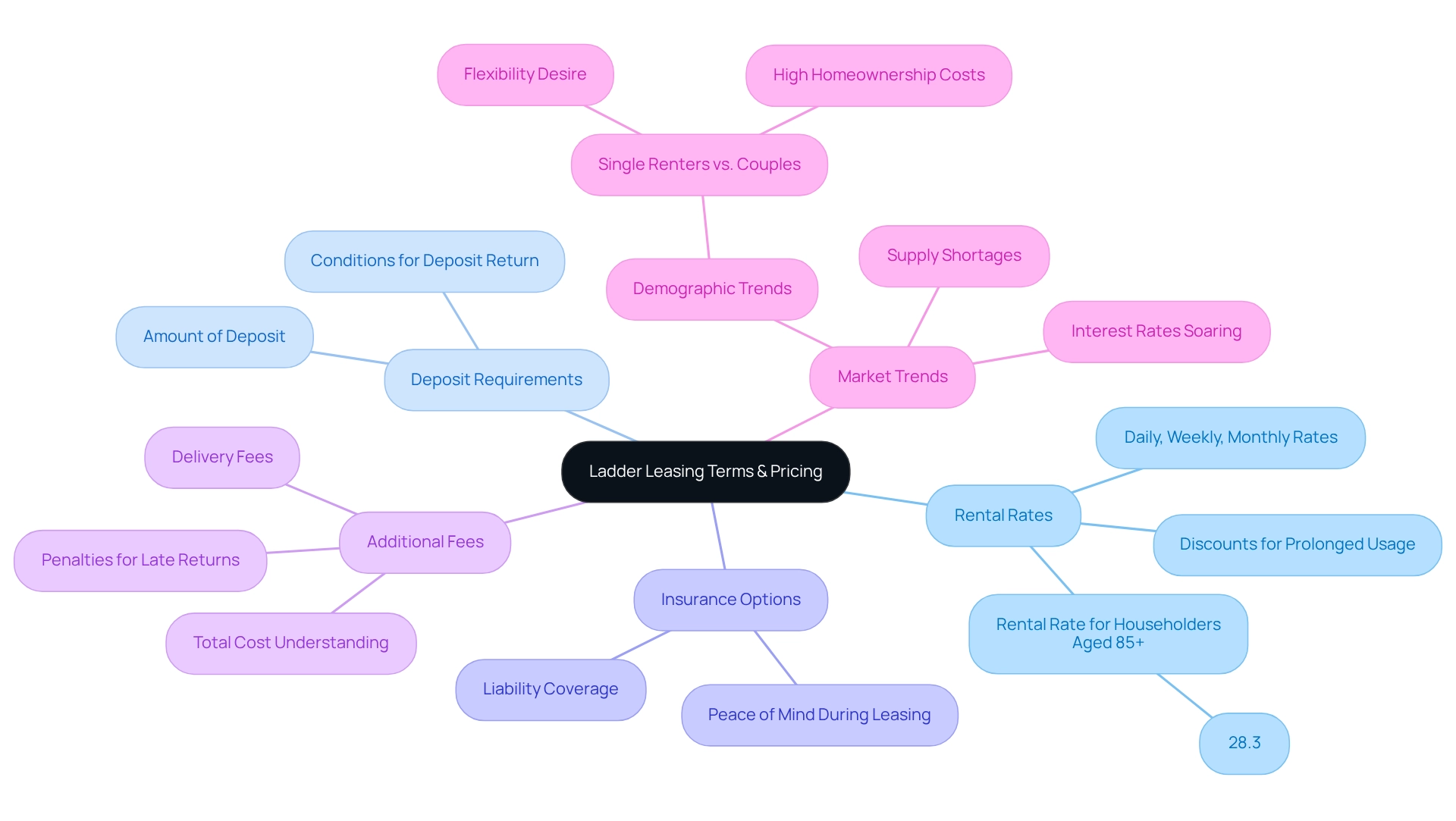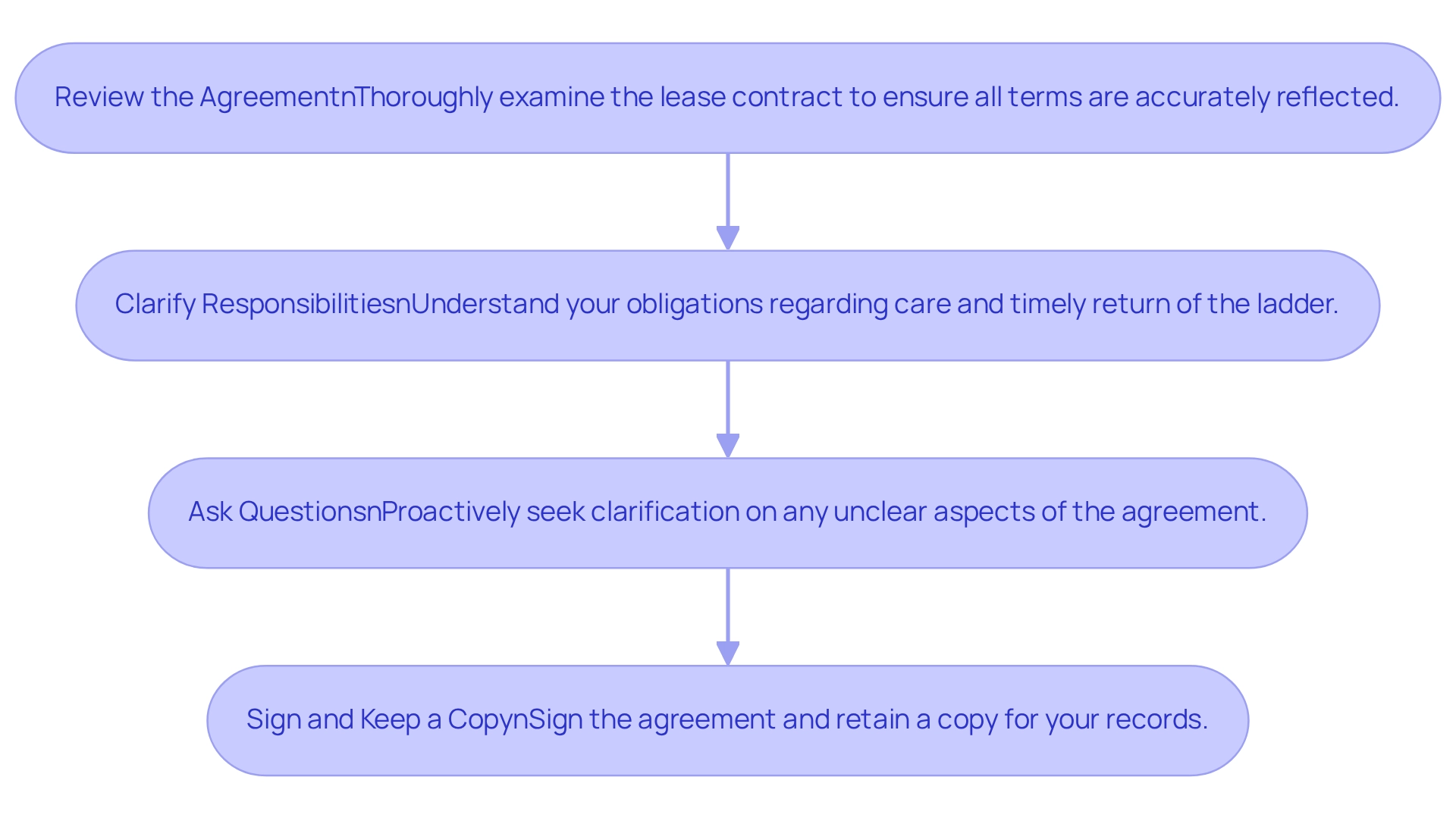Overview
To achieve success in Austin ladder rental, it is essential to follow four key steps:
- Understanding ladder types
- Researching rental companies
- Comparing rental terms and pricing
- Effectively finalizing the rental agreement
Selecting the right ladder for specific tasks not only enhances safety but also ensures efficiency in completing projects. Furthermore, conducting thorough evaluations of rental services allows customers to identify the most reliable providers in the market. Being aware of costs and conditions is crucial; it helps in making informed decisions and avoiding unexpected fees. Finally, ensuring clarity in rental agreements is paramount to prevent misunderstandings, guaranteeing a smooth rental experience. By adhering to these steps, customers can navigate the rental process with confidence and ease.
Key Highlights:
- Understanding ladder types is crucial before renting; they include step stools, extension equipment, multi-position structures, and platform steps, each serving different purposes.
- Ladder classifications are based on weight ratings: Type I (heavy-duty), Type II (medium-duty), and Type III (light-duty), impacting safety and compliance.
- When renting, conduct thorough online research, evaluate equipment quality, seek recommendations, and assess customer service to find reliable rental companies.
- Consider rental rates, deposit requirements, insurance options, and additional fees when comparing rental terms and pricing to avoid unexpected costs.
- Finalize the rental agreement by reviewing terms, clarifying responsibilities, asking questions, and retaining a signed copy for reference.
Introduction
In the dynamic realm of construction and home improvement, selecting the right ladder is crucial—it can determine the difference between a successful project and a safety mishap. With an extensive array of ladder types available for rent, from robust step ladders to versatile multi-position options, understanding the specifications and applications of each empowers individuals to make informed decisions.
As the demand for dependable ladder rental services continues to rise, especially in urban areas like Austin, evaluating rental companies and comparing pricing becomes essential. This guide explores the intricacies of ladder rentals, providing insights on:
- Choosing the appropriate equipment
- Navigating rental agreements
- Ensuring a seamless experience that prioritizes safety and efficiency
Understand Ladder Types and Specifications
Before renting a climbing tool, it is essential to understand the various types available and their specifications.
Step Stools: These self-supporting structures are ideal for indoor tasks and come in various heights. Particularly useful for activities such as painting or changing light bulbs, they prioritize stability and ease of access. The average weight capacity for step stools typically ranges from 200 to 300 pounds, depending on the type.
Extension Equipment: Designed for greater heights, extension equipment is perfect for outdoor tasks like roof repairs or tree trimming. They can be extended to various lengths, offering flexibility for different projects. Selecting an extension that meets the required height and weight specifications is crucial for safety.
Multi-Position Structures: These adaptable tools can be configured in various ways, making them suitable for a wide range of tasks. Their versatility allows for use in different settings, from indoor maintenance to outdoor construction, enhancing their utility on job sites.
Platform Steps: Providing a secure working platform, these structures are ideal for activities that require extended standing, such as painting or electrical tasks. They offer a stable foundation, minimizing the risk of accidents during prolonged use.
Understanding the classifications of these tools—Type I (heavy-duty), Type II (medium-duty), and Type III (light-duty)—along with their respective weight ratings, is vital for ensuring safety and compliance with project requirements. When working near exposed energized electrical conductors, it is imperative to utilize non-conductive equipment to prevent electrical hazards. Additionally, always remember to ascend cautiously, remain centered on the rungs, and use accessories to secure tools properly. By selecting the appropriate equipment for your specific job, you can enhance safety and reduce the likelihood of accidents on the worksite. For inquiries and reservations, contact EZ Equipment Rental at (214) 951-7800.
Research and Evaluate Rental Companies in Austin
To identify the top ladder rental companies in Austin, follow these essential steps:
- Conduct Thorough Online Research: Initiate your search by exploring equipment leasing services in Austin. Leverage review platforms such as Yelp and Google to evaluate customer satisfaction and gather insights on service quality.
- Evaluate Equipment Quality: Visit the websites of potential rental companies to scrutinize their inventory. Ensure they provide well-maintained equipment that adheres to safety regulations, which is crucial for operational efficiency. As emphasized by the Ezequipment Content Team, "This extensive selection, combined with a steadfast commitment to quality and safety, guarantees that projects are executed efficiently and effectively."
- Seek Recommendations: Engage with local contractors or acquaintances who have rented ladders in the past. Their firsthand experiences can offer invaluable perspectives on reliable leasing services.
- Assess Customer Service: Reach out to the businesses directly to gauge their responsiveness and willingness to address your inquiries. Exceptional customer support often indicates a trustworthy leasing company.
In a competitive market, the demand for reliable scaffold leasing services, such as austin ladder rental, is robust, particularly within the construction sector. Companies like EZ Equipment Rental distinguish themselves through their unwavering commitment to quality assurance and customer satisfaction. Their comprehensive delivery and pickup services significantly enhance logistical efficiency, as illustrated in a case study where EZ Tool Rental alleviated the burden of transporting equipment for customers. By adhering to these steps, you can ensure a successful borrowing experience in Austin.
Compare Rental Terms and Pricing
When assessing ladder leasing terms and pricing, it’s essential to consider several critical factors.
- Rental Rates: Assess daily, weekly, and monthly rates, as these can vary significantly. Numerous leasing firms provide reductions for prolonged usage durations, making it economical for extended projects. Notably, the leasing rate for householders aged 85 years and over is 28.3%, underscoring the importance of understanding leasing trends in the broader market.
- Deposit Requirements: Be aware that most leasing firms will require a deposit. Understanding the amount and the conditions for its return is crucial to avoid unexpected costs.
- Insurance Options: Investigate whether the leasing company provides insurance for the equipment. This coverage can protect you against liability in the event of damage, providing peace of mind during your leasing period.
- Additional Fees: Clarify any potential extra charges, such as delivery fees or penalties for late returns. Acquiring a clear understanding of the total costs upfront can help you avoid financial surprises and ensure a smoother leasing experience.
In a competitive market where interest rates have soared and supply has been hard to come by, staying informed about these aspects is vital for successful equipment management. The inclination towards leasing among unmarried people, as shown by studies from Harvard University, further complicates the leasing environment, highlighting the necessity for construction project managers to be aware of demographic trends that may affect leasing demand. Comprehending these elements will assist you in maneuvering through the changing lease rates influenced by demand and availability.

Finalize Your Ladder Rental Agreement
To successfully finalize your ladder rental agreement, follow these essential steps:
- Review the Agreement: Begin by thoroughly examining the lease contract to ensure that all discussed terms are accurately reflected. This includes the duration, pricing, and any additional fees that may apply. Understanding the pricing structure is crucial, especially considering that the average equipment leasing business allocates approximately 6% of annual revenue to salaries and wages.
- Clarify Responsibilities: It is vital to clearly understand your obligations regarding the care and timely return of the ladder. Be aware of potential charges for damages or late returns, as these can significantly impact your overall costs. As highlighted in the case study "Financial Forecasting for Equipment Rental Businesses," awareness of these dynamics is essential for effective budget management.
- Ask Questions: If any aspect of the agreement is unclear, proactively seek clarification from the leasing company. Addressing uncertainties before signing is critical to avoid misunderstandings later. As Adam Hoeksema, co-founder of ProjectionHub, states, "If you have any questions about the data or how to utilize the data in your financial forecasting process, please don’t hesitate to reach out to us!" This proactive approach ensures informed decision-making.
- Sign and Keep a Copy: Once you are confident in the agreement, sign it and retain a copy for your records. This document will serve as a vital reference throughout the leasing period, ensuring you are aware of your rights and responsibilities. Remember, comprehending both revenue and expense dynamics is key to a successful rental experience.

Conclusion
Selecting the right ladder for any construction or home improvement project is paramount for ensuring safety and efficiency. Understanding the various types of ladders—from step ladders ideal for indoor tasks to extension ladders that reach great heights—is essential. Each ladder type has specific applications and weight capacities; choosing the right one can significantly reduce the risk of accidents on the job site.
In addition to understanding ladder types, evaluating rental companies is crucial for a successful rental experience. Conducting thorough online research, checking equipment quality, and assessing customer service can help identify reputable providers in Austin. Companies that prioritize quality assurance and customer satisfaction, such as EZ Equipment Rental, enhance the overall rental process.
Furthermore, being well-informed about rental terms and pricing is vital. By comparing rental rates, understanding deposit requirements, and clarifying potential additional fees, individuals can avoid unexpected costs and ensure a smoother rental experience. Finalizing the rental agreement with careful attention to detail establishes clear responsibilities and expectations, contributing to a positive rental experience.
Ultimately, making informed decisions regarding ladder rentals facilitates project success while prioritizing safety on the job. With the right knowledge and preparation, anyone can navigate the ladder rental landscape effectively, ensuring that all projects are completed safely and efficiently.
Frequently Asked Questions
What types of climbing tools are available for rent?
The available types of climbing tools include step stools, extension equipment, multi-position structures, and platform steps.
What are step stools used for and what is their weight capacity?
Step stools are self-supporting structures ideal for indoor tasks such as painting or changing light bulbs. Their average weight capacity typically ranges from 200 to 300 pounds, depending on the type.
When should extension equipment be used?
Extension equipment is designed for greater heights and is perfect for outdoor tasks like roof repairs or tree trimming. It can be extended to various lengths for flexibility in different projects.
What are multi-position structures and their benefits?
Multi-position structures are adaptable tools that can be configured in various ways, making them suitable for a wide range of tasks, both indoors and outdoors. Their versatility enhances utility on job sites.
What is the purpose of platform steps?
Platform steps provide a secure working platform ideal for activities that require extended standing, such as painting or electrical tasks. They offer a stable foundation to minimize the risk of accidents during prolonged use.
What are the classifications of climbing tools and why are they important?
Climbing tools are classified into Type I (heavy-duty), Type II (medium-duty), and Type III (light-duty), each with specific weight ratings. Understanding these classifications is vital for ensuring safety and compliance with project requirements.
What safety precautions should be taken when using climbing tools?
When working near exposed energized electrical conductors, it is imperative to use non-conductive equipment to prevent electrical hazards. Additionally, always ascend cautiously, remain centered on the rungs, and use accessories to secure tools properly.
How can I make inquiries or reservations for renting climbing tools?
For inquiries and reservations, you can contact EZ Equipment Rental at (214) 951-7800.




